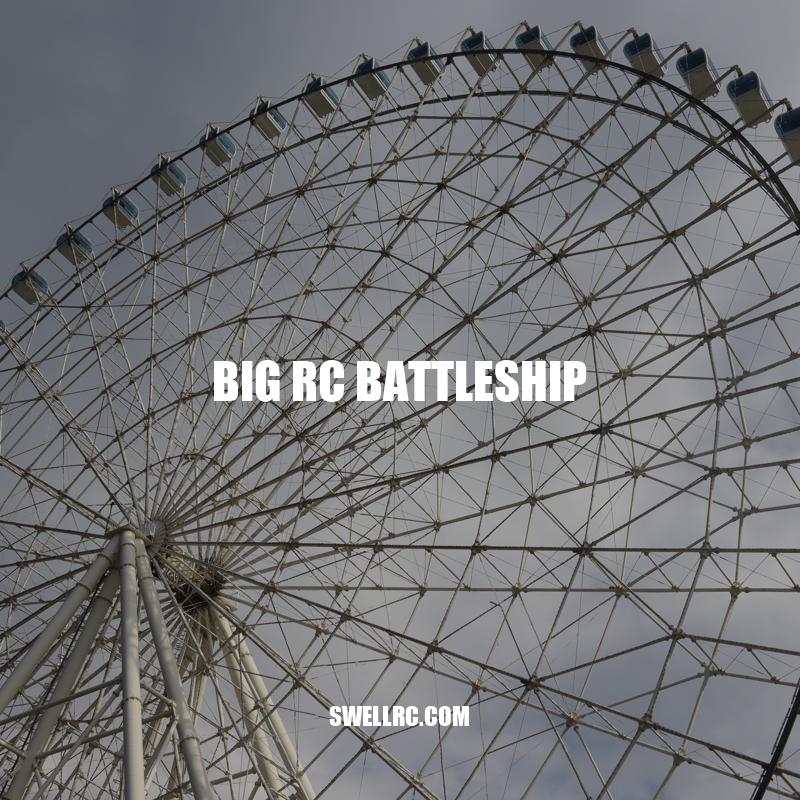Exploring RC Battleships: Features, Types, and Applications
Remote-controlled battleships or RC battleships are miniature versions of real-life battleships that have gained tremendous popularity among enthusiasts worldwide. These small-scale boats offer a realistic experience of boating, with intricate details and features that are synonymous with their real-life counterparts. RC battleships come in different shapes and sizes, ranging from small-scale models to larger, more detailed versions that offer realistic features. They are designed to perform various tasks, including leisure activities, competitions, and even military simulations. Designing these machines starts with sourcing the appropriate materials, including wood, nylon, and plastic, before incorporating technological advancements that can make them as advanced as GPS operated propulsion systems. Building these miniature war machines can be complex, requiring technical knowledge and patience, but the end result is a rewarding experience for those who admire and appreciate the coastguard. Once complete, the RC battleships are powered using remote controllers that typically rely on radio frequencies to manipulate their movement. These boats have advanced features ranging from gun turrets, the engine room, to the bridge of a destroyer, making them look and feel realistic.
Types of RC Battleships
RC battleships come in different variations and sizes, and some are designed to offer unique capabilities. Here are some of the most common types of RC battleships:
- Destroyers: These are small-scale battleships that can carry various weapons, including torpedoes and anti-aircraft weapons. They are typically used for reconnaissance, escort, or screening of naval forces.
- Cruisers: These are large and heavily armed vessels that can engage in battle with other battling machines. They are typically designed to carry support weapons and have ample storage for equipment and personnel to support ground operations.
- Aircraft Carriers: These are multi-purpose vessels that can house aircraft, helicopters, and other tools that can conduct aerial missions. They are used to launch air strikes on enemy targets during military operations and can offer air support to ground troops during amphibious assault missions.
There are also battleships and other naval vessels from various historical periods that are available for enthusiasts to make. These include models of popular battleship classes such as the Bismarck, the Yamato, and the USS Missouri. Some excellent options include the RC Warship Combat website that offers a huge collection of RC battleships and useful information on how to build your RC battleship. With many models and features to choose from, big RC battleships are becoming popular among all naval hobbyists alike and make an excellent addition to any enthusiast’s collections.
What are the 5 types of battleships?
There are five main types of battleships:
| Type | Description |
|---|---|
| Battleship | The largest, most heavily-armed and armored type of battleship. |
| Battlecruiser | Similar to battleships in design and armament, but with less armor and higher speed. |
| Pre-dreadnought battleship | An obsolete type of battleship that was built in the late 19th and early 20th centuries. |
| Dreadnought battleship | A new type of battleship that was introduced in 1906 and revolutionized naval warfare. |
| Super-dreadnought battleship | An even larger and more heavily-armed type of battleship that was developed after World War I. |
To learn more about battleships, you can visit websites such as naval-encyclopedia.com or check out books like “Battleships of the World” by John Fidler.
Designing a big RC battleship requires technical knowledge, skill, and a lot of patience. Here are some materials that are commonly used to make RC battleships:
- Nylon: flexible, resilient, lightweight, and durable. Good for modeling small-scale ships and can withstand damage.
- Wood: stable, versatile, and has excellent shaping properties. Provides an authentic appearance, is resistant to warping, and can be sealed or painted for added protection.
- Plastic: lightweight, cost-effective, and mass-produced. Easy to find and modify and can be designed to have specific features.
Some complex features like gun turrets, engine rooms, and bridges can make designing a big RC battleship challenging. It would be best to have technical knowledge to create these sophisticated features.
There are several online resources and marketplaces for big RC battleship kits, including:
- Hobbylinc: The website offers a wide range of RC battleships kits from various manufacturers, including Tamiya, Trumpeter, and Dragon Models USA.
- eBay: The online marketplace offers users a chance to explore and purchase different RC battleships kits and accessories from international sellers.
- RC Warship Combat: The site offers useful information about designing and building big RC battleships and operates as an active community forum for enthusiasts.
Depending on your preference, budget, and technical knowledge, you can build a big RC battleship kit from scratch or buy a pre-manufactured model. Regardless, creating a big RC battleship takes time, patience, and passion.
What materials are used to make RC boats?
There are different materials used to make RC boats. The most common ones are:
- Plastic: it is affordable and perfect for beginners, although not as powerful nor as fast as other materials.
- Wood: it is versatile and can be customized. However, it requires more maintenance than plastic.
- Fiberglass: it is more expensive than plastic or wood, but it is lighter, faster, and more durable.
- Carbon fiber: it is the most expensive material for RC boats, but it is also the strongest and lightest, providing higher speed and maneuverability.
There are many websites and products available for RC boats hobbyists. Some examples are:
- HorizonHobby.com offers a variety of RC boats and accessories in different materials and sizes.
- Amazon.com has a wide selection of RC boats and spare parts for all levels and budgets.
- ProPShopHobbies.com specializes in RC boat kits, offering high-quality materials and custom designs.
Key Features
RC battleships come equipped with specific features and specifications that make them unique. Here are some key features that make big RC battleship stand out:
- Size: RC battleships are available in different sizes, ranging from small-scale models to larger, more detailed versions that offer realistic features.
- Propulsion systems: Some RC battleships use motor-based propellers, while others use jet-powered engines. Some advanced models even have GPS-controlled propulsion systems.
- Weaponry: RC battleships’ weapon systems include torpedoes, cannons, machine guns, and missile launchers, making them appropriate for different combat scenarios.
- Realistic features: RC battleships offer realistic features, including realistic sounds, LED lighting, smoke generators, and other similar features that mimic the actual ships.
Advancements in technology have enabled RC battleship manufacturers to develop even more sophisticated features, including:
- Autonomous controls: Some models can operate autonomously, without needing to be controlled by remote for a particular period.
- Wi-Fi and Bluetooth capabilities: These technologies offer increased control and range for users operating big RC battleship.
- Integration with virtual reality technology: This allows users to operate the battleships and experience the environment they’re playing in using virtual reality tools like VR headsets.
Some popular RC battleship manufacturers specializing in advanced models include:
- HobbyTron: A prominent supplier of RC products, offering an extensive range of RC battleships at different price ranges.
- NitroRCX: This manufacturer offers advanced Remote Control Battleships, including destroyer-style models that offer realistic features and sophisticated weaponry.
- Tamiya: Produces a wide array of realistic RC battleship models, including the ever-popular Yamato and the Mississippi. These vessels carry realistic features and an array of armaments.
RC battleships have become increasingly popular worldwide, offering a unique and exciting experience to enthusiasts. As technology advances, we can expect even more advanced features, increased control capabilities, and realistic features.
What makes a good battleship?
A good battleship is one that has a combination of the following qualities:
- Powerful and accurate weaponry
- Effective armor and protection systems
- Advanced technology for navigation and targeting
- High speed and maneuverability
In addition, it should also have a well-trained crew and be able to operate effectively in different environments.
For more information on battleships, you might want to check out military websites like navy.mil or globalfirepower.com, or you could take a look at online retailers that specialize in model battleships like modelshipmaster.com or modelerscentral.com.
Application and Utility
RC battleships have a wide range of applications, including leisure activities, competition, educational purposes, and simulation training. Here are some ways RC battleships can be used:
- Recreational activities: RC battleships are excellent leisure-time options that can be operated in a pond or other bodies of water and can also be used for racing or other competitions.
- Educational purposes: RC battleships can be utilized in teaching and educating people about naval warfare, engineering, and maritime principles.
- Military simulations and training: The US Navy uses RC models of ships to test new equipment, weapons, and to learn how to navigate new ships safely. Moreover, militaries can also simulate different scenarios and train naval officers and sailors.
RC battleships have quite a few advantages over full-sized vessels, including:
- No Risk to Real Players: Unlike full-sized vessels that carry a human crew, RC battleships do not pose any danger or risk.
- Cost-effective: RC battleships can be built with lower costs, making them more affordable than regular, full-sized vessels.
- Easy to transport: Small-scale RC battleships can be transported easily, allowing users to set up games at different locations. Furthermore, they take up less space, allowing people to store the boats conveniently.
One of the benefits of big RC battleships is that they’re readily available and accessible. You can purchase RC battleships from a variety of websites, including:
- Amazon: A popular online shopping website, offering over 500 different kinds of RC battleships at different price ranges, offering a wide variety of options to choose from.
- Banggood: An online store that deals with RC products, offering free shipping for items shipped worldwide.
- Horizon Hobby: Known for its wide range of RC products, Horizon Hobby is an excellent option to find various RC battleships at various price ranges.
What are battleships used for?
Battleships are heavily armored warships designed to engage and defeat other ships using their powerful guns and missiles. They are typically used by naval forces for offensive and defensive operations in open waters or near the coastline. Some common uses for battleships include:
- Protecting and supporting ground troops during amphibious assaults
- Destroying enemy naval vessels and bases
- Providing naval gunfire support for friendly forces on land
- Enforcing naval blockades
Battleships played a significant role in major conflicts throughout history, including World War I and World War II. However, with the advent of advanced missile technology and the increasing importance of air power, battleships have largely been replaced by other types of naval vessels, such as aircraft carriers and guided missile destroyers.
For more information on naval history and technology, check out websites such as naval-technology.com or navalhistory.org.
Conclusion
RC battleships are miniature versions of the actual naval vessels built for a wide range of applications. These boats are popular among hobbyists and enthusiasts worldwide, providing a real-life experience of what naval battles are all about. From recreational activities to educational purposes and military simulations, RC battleships have proved to be versatile machines, offering numerous benefits, including cost-effectiveness, transportation convenience, and safety. Furthermore, technological advancements continue to improve the quality of these miniature boats, offering enthusiasts a more realistic experience.
In conclusion, RC battleships offer an opportunity to experience naval warfare without exposing anyone to harm and give people a chance to learn from real-life events. Small-sized models of these boats can be transported easily, and they come at different price ranges. With the wide plethora of options available, hobbyists have a large selection of models and accessories and can find something right for them. Therefore, RC battleships are a great fit and a perfect addition to the world of remote control enthusiasts.



